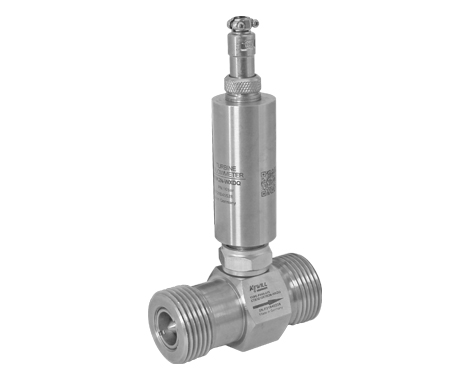Introduction
Principle & Structure
Turbine flowmeters are a type of velocity flowmeter. As shown in the figure below, a turbine is placed in the center of the pipeline, and the two ends are supported by bearings. When the fluid passes through the pipeline, it impacts the turbine blades and generates a driving torque for the turbine, so that the turbine can overcome the friction torque and fluid resistance torque to generate rotation. Within a certain flow range, for a certain viscosity of the fluid medium, the rotational angular velocity of the turbine is proportional to the fluid flow rate. Therefore, the fluid flow rate can be obtained from the rotational angular velocity of the turbine, so that the fluid flow through the pipeline can be calculated.
The rotational speed of the turbine is detected by a sensor coil mounted outside the casing. When the turbine blade cuts through the magnetic field lines created by the permanent magnet steel in the casing, it causes a change in the magnetic flux in the sensing coil. The sensing coil sends the detected magnetic flux periodic change signal to the preamplifier, amplifies and shapes the signal, generates a pulse signal proportional to the flow rate, and sends it to the unit conversion and flow accumulation circuit to obtain and display the cumulative flow value; At the same time, the pulse signal is also sent to the frequency-current conversion circuit, and the pulse signal is converted into an analog current, thereby indicating the instantaneous flow value.
main feature
● Installed with high-reliability long-life bearings
● Excellent repeatability, suitable for batching
● Excellent low flow rate measurement performance
● Extremely fast response, suitable for batch control and proportioning control applications
● Rotor with multi-blade structure, high precision
● Steam cleaning allowed
● The compact type is suitable for equipment installation
application
● Refined oil, light crude oil, gasoline, light oil, jet fuel, light diesel oil, naphtha, ethylene, etc.
● Lubricating oil, hydraulic oil, etc.
● Water, pure water, distilled water, deionized water, desalinated water, demineralized water, etc.
● Alcohol, benzene, toluene, xylene, butadiene, carbon tetrachloride, methylamine, acrylonitrile, etc.
● Formaldehyde, acid, caustic soda, carbon disulfide, etc.
● Milk, coffee, etc.
● High temperature medium such as heat transfer oil and hot kerosene





